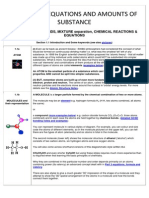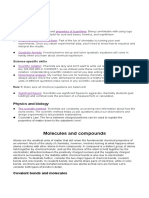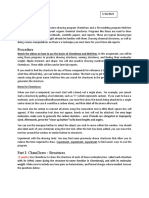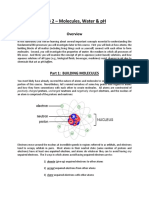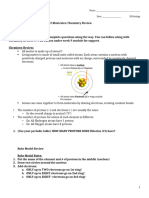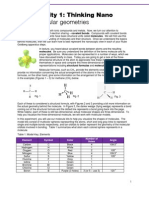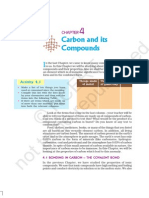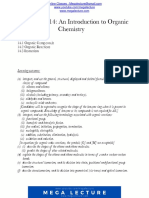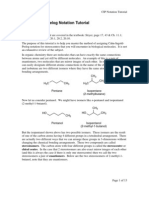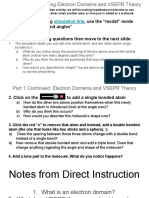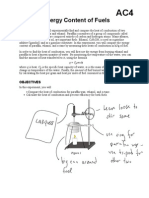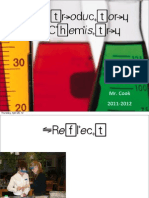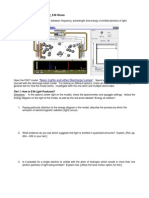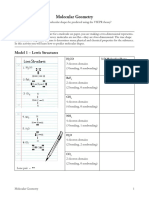Fuel Molecules
Fuel Molecules
Uploaded by
Phillip CookCopyright:
Available Formats
Fuel Molecules
Fuel Molecules
Uploaded by
Phillip CookCopyright
Available Formats
Share this document
Did you find this document useful?
Is this content inappropriate?
Copyright:
Available Formats
Fuel Molecules
Fuel Molecules
Uploaded by
Phillip CookCopyright:
Available Formats
AE
Activity 1: Fuel Molecules Molecular Geometries at Nanoscale
You have studied bonding in both ionic compounds and metals. Now, we turn our attention to compounds that have bonds of electron sharing covalent bonds. Compounds with covalent bonds between the nonmetallic elements have basic structural units called molecules. We will first use this activity to get a basic understanding of molecules and their structure. Once we understand the basics behind molecules, then we can learn how to best represent the nanoscopic view and predict properties of molecules based upon their geometries. In lecture, you heard about covalent bonds between atoms and the resulting molecules. Be sure you understand the definition of the terms molecule and its proper applications. Molecules can be represented in a number of ways, which we have discussed briefly in class. Today you are going to get a look at the threedimensional structure of the atom to appreciate how these molecules orient themselves in space and compare this three-dimensional shape to other representations including structural formulas and molecular formulas. Molecular formulas, such as CH4, provide the elements covalently bonding, but they provide no information concerning the actual arrangement of the atoms in the molecule. Structural formulas, on the other hand, give some information on the arrangement of the molecule, as you can see in the examples (Figures 1 3) for methane (CH4) below.
Fig. 1
Fig. 2
Fig. 3 .
Each of these is considered a structural formula, with Figures 2 and 3 providing a bit more information on the actual geometry behind the molecule. In Figure 3, the darker wedge (flying wedge) represents a bond coming out of the structural formula and the dotted line represents a bond going back into the page. While helpful, each of these is still two-dimensional; actual molecular shapes are three-dimensional. To help you visualize the three-dimensional molecule, we will work with molecular models. In this experiment, you will use our molecule kits to help you visualize the shapes of molecules. The model kits consist of multicolor spheres representing the atoms, short and long gray links to represent single and multiple bonds respectively, and tan orbitals to better represent the geometry of the molecular orbitals involved in bonding. Table 1 summarizes what atom each colored sphere represents in a molecule. Table 1: Model Key, Elements Element Carbon Hydrogen Oxygen Nitrogen Sulfur Fluorine Iodine Bromine Chlorine Boron Symbol C H O N S F I Br Cl B Color Black White Red Blue Yellow Gray Green Green Green Purple (3 holes) Number of Holes 4 1 2 4 2 1 1 1 1 3 (or 5 use 3) Angle 109.5
o o
105 o 109.5 o 105
120
P R E P A R I N G REVIEWING STRUCTURES LEARNING OBJECTIVES
Reread the introduction to this activity. Once finished, answer the following questions.
1. What types of atoms typically covalently bond? 2. Define molecule. 3. Explain how the periodic table can predict how many bonds each covalently bonding atom will
probably make. This trend is also a very good rule of thumb, but will have notable exceptions.
4. What is the molar mass of carbon? What do you think the molar mass is of methane, mentioned
in the introduction? As always, include an objective for this activity and share that objective with a teammate or laboratory partner. If you have questions during the activity, be sure to ask your instructor.
E X P E R I M E N T I N G COLLECTING DATA & PREDICTING
Building molecules
In your experimenting section you will start at table spanning both columns of the investigating section. The table will have five columns: molecule name, molecular formula, Lewis dot structure, structural formula, molar mass, and instructors initials. (Your instructor will sign off on a molecule after you have built it, so I know you are building the right things.) Make each row as you go, so that you arent trying to cram a complicated drawing into a small space! Be careful with the models. They may just be plastic, but they are expensive, well-designed bits of plastic. Keep the kit organized and all of the parts on the table (i.e. no model fights, please).
Part A Electron Geometries of Basic Molecules
1. Construct models of water, methane (CH4), and ammonia (NH3). Each of these molecules forms shapes which represent certain molecular geometries or arrangements of hybrid orbitals, or the orbitals that result from the covalent bonding of the atoms. Methane is referred to as tetrahedral in shape. As you can see in the Lewis dot structure, both water and ammonia have electrons clouds that are tetrahedral, but since lone pairs are involved, the geometry in the models is slightly different. We call the resulting molecular geometry of ammonia trigonal pyramidal, and the resulting molecular geometry of water bent. 2. Molecules can also have a linear arrangement of both the electron geometries and the molecular geometries of the molecular orbitals. The diatomics of nitrogen gas (N2), and oxygen gas (O2), as well as carbon dioxide gas (CO2) are examples of these. Construct these models and complete the chart for each. 3. Besides nitrogen gas and oxygen gas, there are other elements that covalently bond to themselves. These are referred to as diatomic elements. These diatomic elements are hydrogen, nitrogen, oxygen, fluorine, chlorine, bromine, and iodine. Create diatomic hydrogen and bromine. Underneath the structural formula in your table, name the shape.
Part B Organic Compounds
1. Organic compounds are compounds based on the element, carbon. There are different classes of organic compounds. Some have single bonds, and those are called alkanes. Some alkanes include methane (which you built in Part A), ethane (C2H6) and octane (C8H18). Construct these two models and complete the chart for each. Do not draw Lewis dot structures for the organics. 2. Some organic compounds have double bonds, and those are called alkenes. The most basic alkene is ethene (C2H4), and another example is propene (C3H6). Construct these two models and complete the chart for each. 3. Organic molecules have groups of atoms bonded to them that interact or react in predicable ways. These groups of atoms are called functional groups. Four functional groups that are significant are hydroxyl (-OH), amine (-NHx), carboxyl (-COOH) and thiol (-SH). Build each functional group and attach it to ethane (built in step 1 of Part B).
A N A L Y Z I N G EVAPORATION & INTERMOLECULAR FORCES
Reading: Fuel Molecules
Check Schoology for a reading pertaining to this activity.
Questions: Fuel Molecules
1. Draw the following molecules electron dot structures and describe their molecular geometries. a. Cl2 b. CH2Cl2 c. Urea 2. Seltzer water is a mixture of aqueous carbon dioxide, CO2(aq), and aqueous sodium chloride, NaCl(aq). Draw this mixture at the nanoscale. 3. Investigate the structures for ethane, ethanol and ethyne. Compare and contrast the structures of these organic compounds.
Figure 1: amino acid - cysteine
4. Take a look at Figure 1 to the right. Rewrite this in your notebook. Circle and name the functional groups. 5. Traditional fuel molecules used today from coal and petroleum that have the most energy are made of long chains of carbons and contain no oxygen. Based on this, what type of molecules from Part B do you predict contain the most potential energy? 6. One of the components of jet fuel is a long chain of 14 carbons all single bonded, surrounded by hydrogen atoms. What is the formula and molar mass for this compound? 7. Alcohols are single-bonded carbon chains that contain a hydroxyl group and are named by dropping the final e and adding -ol. What do you predict is the structure and formula for ethanol? (Hint: You already build this in Part B.) 8. If ethanols potential energy is described as 28.9 kJ/g, how many kJ of potential energy are in 1.00 mole of ethanol? (Hint: This is a multistep problem.) No critical thinking for this activity. Youve contemplated the nanoscale enough for this one!
You might also like
- Test Bank For Organic Chemistry Mechanistic Patterns 1st Edition by Ghis William OgilvieDocument32 pagesTest Bank For Organic Chemistry Mechanistic Patterns 1st Edition by Ghis William Ogilviemboogey861No ratings yet
- Student Study Guide and Solution Manual For Organic Chemistry 4e by David Klein 9 76Document68 pagesStudent Study Guide and Solution Manual For Organic Chemistry 4e by David Klein 9 76MA. FRANCESCA DUCOTNo ratings yet
- Kerboodle StuffDocument4 pagesKerboodle StuffRoshNo ratings yet
- CAPE Unit 2 Chemistry NotesDocument207 pagesCAPE Unit 2 Chemistry NotesAshley Cunningham100% (2)
- TBR OChem1 OptDocument324 pagesTBR OChem1 OptRamski100% (12)
- Isomerism in Organic Chemistry: Number 93 WWW - Curriculum-Press - Co.ukDocument5 pagesIsomerism in Organic Chemistry: Number 93 WWW - Curriculum-Press - Co.ukslixsterNo ratings yet
- Molecular Structures Water and PH LabDocument13 pagesMolecular Structures Water and PH Labapi-249772989No ratings yet
- Structural Organic Chemistry. The Shapes of Molecules. Functional GroupsDocument19 pagesStructural Organic Chemistry. The Shapes of Molecules. Functional Groupspatrik710No ratings yet
- 3rd Learning Module_0Document11 pages3rd Learning Module_0manicoleanndNo ratings yet
- GEN CHEM CHEMICAL FORMULA and NAMING OF COMPOUNDSDocument35 pagesGEN CHEM CHEMICAL FORMULA and NAMING OF COMPOUNDSKC KayeNo ratings yet
- Brown's ChemistryDocument223 pagesBrown's ChemistryhirenpanchaniNo ratings yet
- Organic Chemistry Experiment 2Document17 pagesOrganic Chemistry Experiment 2Goh Chun KitNo ratings yet
- Molecmod LabDocument7 pagesMolecmod Labraym6270No ratings yet
- Chemistry 101Document20 pagesChemistry 101Ashlyn BautistaNo ratings yet
- Curso de Quimica IDocument233 pagesCurso de Quimica IEmanuelRomeroGNo ratings yet
- Workbook 01Document15 pagesWorkbook 01Kartik DhandNo ratings yet
- Practical 3Document8 pagesPractical 3KINISHAA A/P TAMIL SELVEN / UPMNo ratings yet
- Chapter 14 - An Introduction To Organic ChemistryDocument29 pagesChapter 14 - An Introduction To Organic ChemistryNabindra RuwaliNo ratings yet
- S1 Gchem Practical Shapes of MoleculesDocument8 pagesS1 Gchem Practical Shapes of MoleculesNorhadi MohamadNo ratings yet
- 11chemistry - Organic chemistry-Notes&VLDocument14 pages11chemistry - Organic chemistry-Notes&VLPrashant SinghNo ratings yet
- Chemistry Final Exam Review 2012Document29 pagesChemistry Final Exam Review 2012elenaNo ratings yet
- Report 1 Learning Software - Benjamin CruzDocument12 pagesReport 1 Learning Software - Benjamin Cruzapi-674986426No ratings yet
- Bio3 Lab02-Fa12-Molecules Water PHDocument16 pagesBio3 Lab02-Fa12-Molecules Water PHVintage Thrift ShopNo ratings yet
- COES110B Chemistry For Engineers Lab 4 - MOLECULE SHAPESDocument8 pagesCOES110B Chemistry For Engineers Lab 4 - MOLECULE SHAPESCJ MangasepNo ratings yet
- Molecular Models MOD 24Document8 pagesMolecular Models MOD 24Katie MihalekNo ratings yet
- Assessments and Rubrics For Unit 2Document13 pagesAssessments and Rubrics For Unit 2api-302258576No ratings yet
- Orgchem Module Edit 2Document74 pagesOrgchem Module Edit 2Nur-aine HajijulNo ratings yet
- Gen Chem 1 Q2 Module 3Document14 pagesGen Chem 1 Q2 Module 3lkNo ratings yet
- Chem.g12 q2w7 Module3 PamplonaDocument16 pagesChem.g12 q2w7 Module3 PamplonaRaymalyn MalynNo ratings yet
- Empirical and Molecular Formulas: Example 2.6Document6 pagesEmpirical and Molecular Formulas: Example 2.6Kate MendozaNo ratings yet
- Problem Set 3 Simulation ActivityDocument12 pagesProblem Set 3 Simulation Activityapi-182809945No ratings yet
- StereochemistryDocument19 pagesStereochemistrysophia del rosarioNo ratings yet
- Ac1 Dominoes Molecules 0910Document3 pagesAc1 Dominoes Molecules 0910Josh PNo ratings yet
- 1) PPT Developed by NVS TeacherDocument58 pages1) PPT Developed by NVS Teachersugeshkumar123456789No ratings yet
- Module 1ADocument5 pagesModule 1APrincess De Leon RodriguezNo ratings yet
- © Ncert Not To Be Republished: Carbon and Its CompoundsDocument21 pages© Ncert Not To Be Republished: Carbon and Its CompoundsSaurabh SinghNo ratings yet
- Stereochemistry Step by Step LearningDocument32 pagesStereochemistry Step by Step LearningSalah DiaaNo ratings yet
- Chapter 14 - An Introduction To Organic ChemistryDocument29 pagesChapter 14 - An Introduction To Organic ChemistrySahana KumarNo ratings yet
- Cahn Ingold PrelogDocument13 pagesCahn Ingold PrelogVivien TeyNo ratings yet
- 3.03 Representing Compounds - Chemical Formulas and Molecular ModelsDocument4 pages3.03 Representing Compounds - Chemical Formulas and Molecular ModelsJinn Allan LuañaNo ratings yet
- 1 - Structure and Bonding - Chemistry LibreTextsDocument3 pages1 - Structure and Bonding - Chemistry LibreTextsMunazNo ratings yet
- Bonding and Hybridizatio1Document16 pagesBonding and Hybridizatio1AB AniketNo ratings yet
- Molecular Modeling by Roxie AllenDocument5 pagesMolecular Modeling by Roxie AllenPaul SchumannNo ratings yet
- ChemistryDocument25 pagesChemistrymariabour.enNo ratings yet
- Unit 1 Module 1Document38 pagesUnit 1 Module 1Pearl NecoleNo ratings yet
- Lewis StructureDocument7 pagesLewis StructureJovenarellanoNo ratings yet
- Carbon Compounds: Presenter: Shannon SmithDocument61 pagesCarbon Compounds: Presenter: Shannon SmithShannon SmithNo ratings yet
- Isomerism in Alkanes, Cycloalkanes, and Alkenes Using Molecular ModelsDocument4 pagesIsomerism in Alkanes, Cycloalkanes, and Alkenes Using Molecular Modelsalbertvdatu278No ratings yet
- Chemistry Report 1Document6 pagesChemistry Report 1Athirah BidinNo ratings yet
- LESSON-2 General Chemistry Grade 11 Lewis StructureDocument46 pagesLESSON-2 General Chemistry Grade 11 Lewis Structuremacolorjohn3No ratings yet
- Optical Isomerism in Organic MoleculesDocument6 pagesOptical Isomerism in Organic MoleculesMohit KarmakarNo ratings yet
- Module 1: Atomic Structure Lecture 1: Structural ChemistryDocument7 pagesModule 1: Atomic Structure Lecture 1: Structural ChemistryVineeta GuptaNo ratings yet
- Chapter 1 Structure and BondingDocument47 pagesChapter 1 Structure and BondingIzzatiSimaaNo ratings yet
- Chemistry Report 1Document6 pagesChemistry Report 1Athirah BidinNo ratings yet
- Molecular Geometry Inquiry ActivityDocument6 pagesMolecular Geometry Inquiry Activityapi-543077510No ratings yet
- 161lab - Molecular - Models Updated 1 27 2014Document15 pages161lab - Molecular - Models Updated 1 27 2014Khaman DassNo ratings yet
- M2 - Common Isotopes and Their UsesDocument99 pagesM2 - Common Isotopes and Their UsesDan Emmanuel MalazarteNo ratings yet
- Carbon and Its CompoundsDocument19 pagesCarbon and Its CompoundssmilecarekkmNo ratings yet
- CH 1 Structure and Bonding Part 1 2423Document13 pagesCH 1 Structure and Bonding Part 1 2423Lance StrikerNo ratings yet
- The New Chemist Company Publications- Accessible Organic Chemistry: The New Chemist CompanyFrom EverandThe New Chemist Company Publications- Accessible Organic Chemistry: The New Chemist CompanyNo ratings yet
- Creating Effective Online Chemistry CoursesDocument13 pagesCreating Effective Online Chemistry CoursesPhillip CookNo ratings yet
- AC Build A Conductivity ProbeDocument9 pagesAC Build A Conductivity ProbePhillip CookNo ratings yet
- AC Build A Conductivity ProbeDocument9 pagesAC Build A Conductivity ProbePhillip CookNo ratings yet
- Chemistry Course OutlineDocument7 pagesChemistry Course OutlinePhillip CookNo ratings yet
- Ac4.Energyoffuels Pretzej@Culver - Org, 3 PretzeJ1Document3 pagesAc4.Energyoffuels Pretzej@Culver - Org, 3 PretzeJ1Phillip CookNo ratings yet
- Ac9 Forensics ChromatorgraphyDocument5 pagesAc9 Forensics ChromatorgraphyJosh PNo ratings yet
- AC5 White PowdersDocument10 pagesAC5 White PowdersPhillip CookNo ratings yet
- POGIL - MeasurementDocument5 pagesPOGIL - MeasurementPhillip CookNo ratings yet
- Case Analysis: Beth OwensDocument8 pagesCase Analysis: Beth OwensPhillip CookNo ratings yet
- Battery Lab Activity PlanDocument5 pagesBattery Lab Activity PlanPhillip CookNo ratings yet
- Parents Presentation Chem 430Document19 pagesParents Presentation Chem 430Phillip CookNo ratings yet
- H 1112Document5 pagesH 1112Phillip CookNo ratings yet
- POGIL - MaterialsDocument4 pagesPOGIL - MaterialsPhillip CookNo ratings yet
- Neon Lights and Other Discharge LampsDocument3 pagesNeon Lights and Other Discharge LampsPhillip CookNo ratings yet
- POGIL - MeasurementDocument5 pagesPOGIL - MeasurementPhillip CookNo ratings yet
- AC1 Thermal ConductivityDocument2 pagesAC1 Thermal ConductivityPhillip CookNo ratings yet
- Finals L2 Chemistry Part 2 VSEPR TableDocument3 pagesFinals L2 Chemistry Part 2 VSEPR TableRhoda Mae CubillaNo ratings yet
- High Spin and Low SpinDocument13 pagesHigh Spin and Low SpinAyanChatterjeeNo ratings yet
- CBO-2 ResoSir cUt6Kj9Document46 pagesCBO-2 ResoSir cUt6Kj9L GoldenmasterNo ratings yet
- Tutorial Questions For CHM 101Document6 pagesTutorial Questions For CHM 101Aina DanielNo ratings yet
- Libre TextsDocument320 pagesLibre TextsAlexandra PorojnicuNo ratings yet
- K00253 - 20190114073510 - Molecular ShapeDocument60 pagesK00253 - 20190114073510 - Molecular ShapeArvind RaveeNo ratings yet
- AP Ch. 8-9 Structures Polarity Review AnswersDocument13 pagesAP Ch. 8-9 Structures Polarity Review AnswersJocelyn Jp PolanskyNo ratings yet
- 05 Valence Shell Electron Pair RepulsionDocument34 pages05 Valence Shell Electron Pair RepulsionTitobiloluwa AlbertNo ratings yet
- 4 - Chemical Bonding & Molecular Structure (Part 2) - Lecture PowerPointDocument51 pages4 - Chemical Bonding & Molecular Structure (Part 2) - Lecture PowerPointfelix devan lopezNo ratings yet
- Answer: (D) Propyne Explanation: The C - C Bond Length 1.54 Å, C C Bond Length 1.34 Å and C C Bond Length 1.20 Å. Since Propyne Has A Triple Bond, Therefore It Has Minimum Bond LengthDocument4 pagesAnswer: (D) Propyne Explanation: The C - C Bond Length 1.54 Å, C C Bond Length 1.34 Å and C C Bond Length 1.20 Å. Since Propyne Has A Triple Bond, Therefore It Has Minimum Bond Lengthaibanand dasNo ratings yet
- Molecular Modeling: A Powerful Tool For Drug Design and Molecular DockingDocument10 pagesMolecular Modeling: A Powerful Tool For Drug Design and Molecular DockingGabrielė BalčiūnaitėNo ratings yet
- CH 9Document11 pagesCH 9Roxanne Mae VillacoraNo ratings yet
- 4.0 CHEMICAL BONDING - NOTES & TUTORIAL Q's..Document72 pages4.0 CHEMICAL BONDING - NOTES & TUTORIAL Q's..Dee -AdilaNo ratings yet
- Full Course General Chemistry NotesDocument401 pagesFull Course General Chemistry Notesankit.shrivastavaNo ratings yet
- CHM101 Chapter 7Document104 pagesCHM101 Chapter 7JojoNo ratings yet
- DPPS-2 P-Block ElementsDocument2 pagesDPPS-2 P-Block ElementsAalokNo ratings yet
- Atoms in Molecules A Quantum Theory 1990 BaderDocument454 pagesAtoms in Molecules A Quantum Theory 1990 BaderJorge ChocksNo ratings yet
- Organic Chemistry NotesDocument29 pagesOrganic Chemistry NotesbitangyarahNo ratings yet
- Chemthink - Molecular ShapesDocument3 pagesChemthink - Molecular Shapesanthonye0878No ratings yet
- Experiment 1 Predicting Molecular Shape and Polarity Using VSEPR TheoryDocument5 pagesExperiment 1 Predicting Molecular Shape and Polarity Using VSEPR TheorynathirahjainiNo ratings yet
- Shah & Anchor Kutchhi Engineering College: Mahavir Education Trust's Chembur, Mumbai - 400 088Document1 pageShah & Anchor Kutchhi Engineering College: Mahavir Education Trust's Chembur, Mumbai - 400 088James jillNo ratings yet
- Molecular Geometry PDFDocument6 pagesMolecular Geometry PDFNikhita VaralaNo ratings yet
- Class 11 Chapter 4 Chemical Bonding and Molecular StructureDocument139 pagesClass 11 Chapter 4 Chemical Bonding and Molecular Structureprateek yadavNo ratings yet
- Practice Exam3 PDFDocument9 pagesPractice Exam3 PDFdave lucasNo ratings yet
- Exceptions To The Octet Rule: Molecules With Electron-Deficient AtomsDocument22 pagesExceptions To The Octet Rule: Molecules With Electron-Deficient AtomsJohn RammNo ratings yet
- ChemistryDocument28 pagesChemistryMikas TesfuNo ratings yet
- Vsepr HandoutDocument2 pagesVsepr Handout20718 LAY BUFFON FERNANDO GROSSONo ratings yet
- Water Molecule StructureDocument9 pagesWater Molecule StructureKezial Angel100% (1)
- 4.11 - Molecular Shapes - The VSEPR Theory - Chemistry LibreTextsDocument1 page4.11 - Molecular Shapes - The VSEPR Theory - Chemistry LibreTextsakwinkelNo ratings yet










